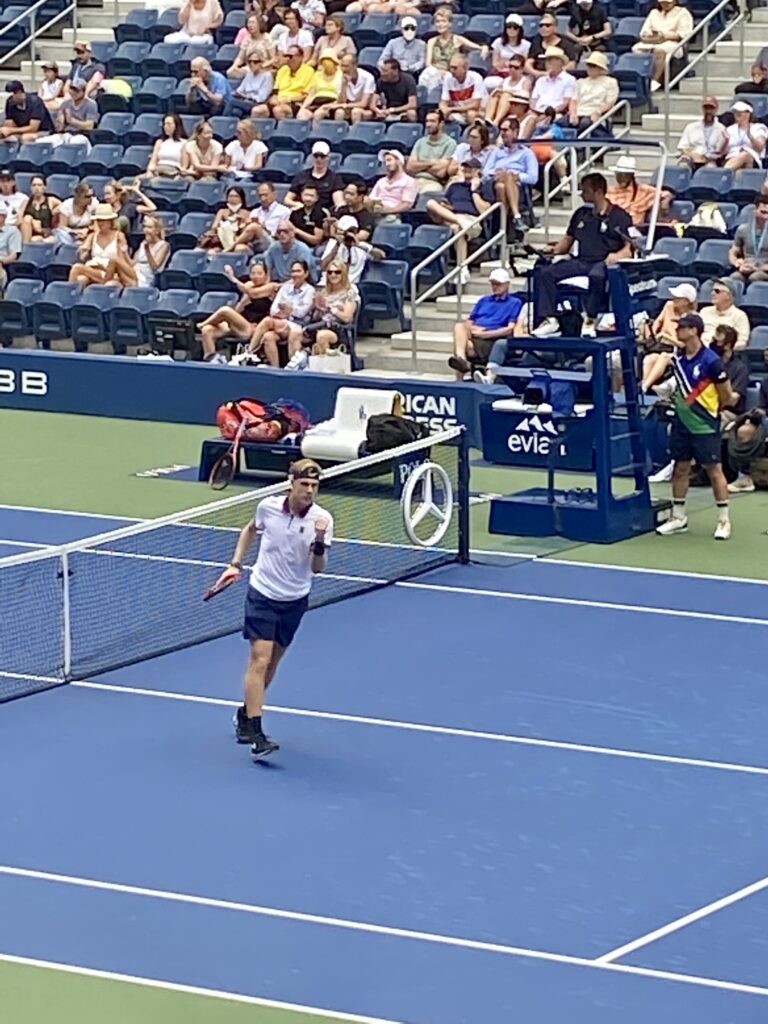
I went to the U.S. Open yesterday to watch some first-round tennis matches. If you’ve never been to the U.S. Open, you should really try to go if you can — even if you’re not a tennis fan. The Billie Jean King National Tennis Center is an absolutely spectacular place to spend a late-summer day. Sure, you can go to one of the big courts to see big names — Arthur Ashe Stadium seats nearly 24,000, and it’s where you’ll find stars like Novak Djokovic and Naomi Osaka — or you can check out one of the outer courts, where you’ll catch top 100 players playing for just a few hundred fans. (Yesterday, I watched a matchup of two top 75 talents from the second row. Pretty cool.)
But one of the highlights of the day was watching Denis Shapovalov, the tenth-ranked player in the world. He played at Louis Armstrong, the second-largest stadium on the grounds, in the middle of a Tuesday afternoon. His was the third match on that court that day, and many of the fans who’d come for earlier matches had drifted out to other courts. Shapovalov played a stadium that was less than a third full.
Still, Shapovalov’s a star in the tennis world, and a player who could absolutely make the finals in Queens this week. To win the U.S. Open requires a player to win seven matches, and the men’s matches can last up to five rounds (and can sometimes go as long as four or five hours). Shapovalov couldn’t afford to let his match go long. He needed to dispatch his opponent (Federico Delbonis, the 47th-ranked player in the world) as quickly as possible.
Shapovalov did just that, winning in straight sets (and in less than two hours). But what I found fascinating was the way Shapovalov stayed engaged at every moment in the match. In front a sparse crowd that seemed more interested in checking their phones than watching the match, it would’ve been easy for Shapovalov to lose focus. But without the crowd keep him engaged, Shapovalov found his own ways to bring the energy. After every point he won, he gave a little fist pump. After big shots, he looked over at his box, nodding to them and letting them know that he was locked in. After breaking serve or winning a set, he’d let out a little scream, or a “Let’s go!” A few times, he gestured to the crowd to make noise.
This was the sort of match — against a talented and experienced opponent — where Shapovalov could’ve lost focus for a bit and let the match stretch into a fourth or fifth set. But he simply refused to let himself disengage. He was both player and hype man, never letting his attention drift, even when the crowd’s energy dropped.
I spent the subway ride home thinking about ways to try something similar with my own work. It’s easy for my energy to slip, especially at the end of a long day of calls. Maybe I need to find ways to take small breaks: A walk around the block to reset, or even a few jumping jacks in the ten minutes between calls. Maybe I need to start keeping a gratitude journal, so I can use those few minutes to jot down thoughts about the good that’s come from that day.
But seeing Shapovalov play, I was reminded that to be at the top of my game, I have to find ways to maintain that focus throughout the day — especially when the energy isn’t naturally there.
———
I took that photo of a Shapovalov fist pump during yesterday’s match.
